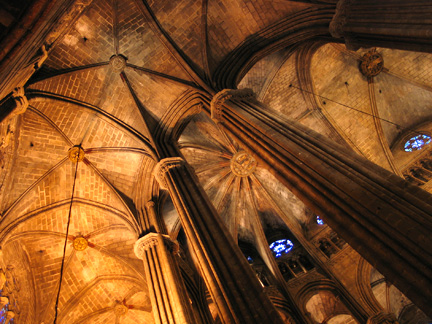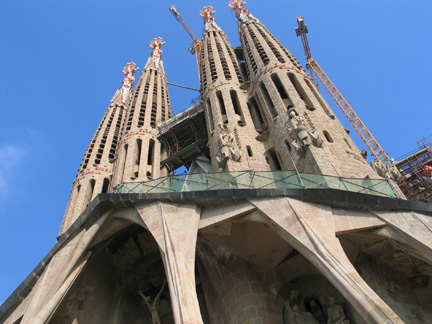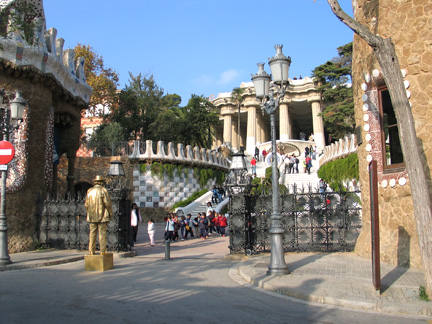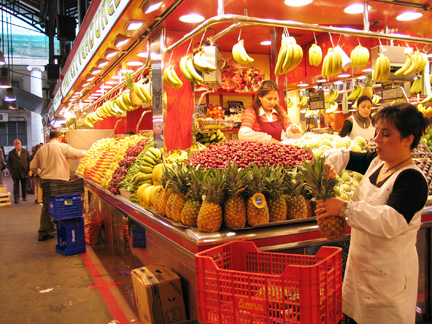
Catedral de Seu was built in the Gothic style in the 13th through 15th centuries.
Bustling Barcelona
The historic Spanish city
is full of life
A LONG the Mediterranean shore of eastern Spain lies Barcelona, one of the great cities of Europe, home to 4.2 million residents.
You can see the main attractions of this country's second-largest city in just a few days by walking through its square-mile historic center. Be sure to see Barcelona's most famous building, Sagrada Familia, the fantasy church designed by eccentric architectural genius Gaudi.
You're likely to spend most of your time in the old section of town, called the Barri Gotic, or Gothic Quarter, a giant pedestrian zone dating to ancient times. This is perhaps the most extensive automobile-free district in Europe (except for Venice, which has no roads). Indeed, one of the most enjoyable activities in Barcelona is taking a walk through its many narrow lanes. They wander, bend and curve like a maze, posing the traveler's question, What's next?
These streets have survived for 2,000 years, ever since the city was established by the Romans, who built a wall around what would became the Gothic Quarter. Earlier, around 500 B.C., the Phoenicians and Carthaginians created a harbor in the area. Over time the Gothic Quarter was ignored and neglected while the rest of the city developed. In recent decades the city realized what a treasure it had with this intact medieval core and has done a great job to keep it that way.
Many of Barcelona's 35,000 independent boutiques are packed into this pedestrian zone, which differs from the American system of identical shops in every mall. Barcelona's retail zone continues north from the Gothic Quarter along the 5KM Shopping Line, a 3-mile corridor extending along trendy boulevards, including the Passeig Gracia. This zone was developed in the late 19th century in the Modernista style. Also called "modernisma," it is a richly decorated version of art nouveau architecture that developed in Barcelona as an expression of Catalan identity.
Barcelona is a bicultural city, with Spanish and Catalan influences. Catalan culture rose here in the ninth century and thrived during eight centuries in the independent kingdom of Catalunya. Its native language is a mixture of French and Spanish which follows its own rules. Barcelona has always had close ties with the rest of Europe; for example, while most of Spain was occupied by Muslims during the Middle Ages, this region was not, but was allied with the Franks.
It's not much of a stretch to say that residents consider themselves Catalan first and Spanish second, although few are pushing for independence anymore. Four TV stations broadcast exclusively in Catalan, and most street signs are also in the native language. Shop and restaurant workers generally speak enough English for American visitors to get by.

Construction of Sagrada Familia Church has been going on for a century.
Day 1
Begin in Barcelona's main square, PlaŤa de Catalunya -- a patch of greenery flanked by two large department stores, El Corte Ingles and FNAC. Catalunya is a transit hub, with several metro and commuter trains running underground, major bus stops and nine streets leading into it. You can catch the open-top tour bus in front of Corte Ingles, but hold off on that scenic ride until tomorrow, after you have seen the heart of town on foot.Rambla: Stroll from Catalunya along this broad pedestrian promenade extending from the square's southwest corner and continuing to the waterfront and column honoring Columbus. The Rambla is Barcelona at its best, day and night. Excellent hotels along the Rambla offer a variety of rates and a central base for your excursions.
All but one lane extending from the east side of the Rambla into the Old Town are for pedestrians only. Rather than walking to the waterfront now, detour into the Gothic Quarter. Half the fun of this layout is getting lost in its alleys, although it helps to have a map and list of destinations for guidance.
One recommended lane is Carrer de la Portaferrissa, lined with fascinating shops and old buildings. It leads to a small but strategic intersection leading to such major destinations as the cathedral, PlaŤa dei Pi, and l'Angel shopping street. For now, swing right to PlaŤa dei Pi for a look at this double plaza with the gothic church of Santa Maria dei Pi. Then continue east toward the cathedral.
Cathedral: Catedral de Seu was first built in the 13th through 15th centuries in the gothic style, with a soaring nave, pointed arches, tall columns, 28 side chapels and a spectacular cloister that is home to a flock of noisy geese with attitudes. Take the elevator to the roof for a stunning view of the town as an orientation for walks to come. This location atop a low hill was home to an earlier Roman temple, then a sixth-century church, so it's no wonder adjacent lanes are dense with historic structures and small plazas.
Royal palace: One block east you will find the former home of kings and queens, the Palau Reial or Royal Palace, now a history museum, the Museu d'Historia de la Ciutat. In 1493, Columbus reported his great discovery of the New World to Ferdinand and Isabella in the palace's spectacular Banqueting Hall, "Salo del Tinell," whose roof is formed by the largest medieval stone arches in Europe. Several other halls and chambers exhibit period paintings, furnishings, weapons, altars and artifacts.
An even more ancient world awaits below street level. The elevator is a time machine whose button says "-2,000 years" rather than "basement," and brings you 30 feet down to the original Roman streets where you can see foundations of former houses, wineries, bakeries, leather factories and fortified towers. Smooth paving of the streets and sewers attest to Roman engineering skills behind the world's most sophisticated cities.
PlaŤa de Sant Jaume: The main Roman street intersection in the underground museum is in approximately the same location of the modern plaza Sant Jaume, home to the city and regional government headquarters. On Sunday afternoons the plaza fills with locals dancing the graceful Sardana, a 1,000-year-old Catalan tradition. A lively road, Carrer de Ferran, runs through the plaza, where throngs are drawn to restaurants and small shops open to 8 or 9 p.m. (they close in the afternoon for siesta).
Music of all kinds emanates from the streets filled with buskers who rely on tips for their income. When you hear some decent sounds, stop awhile and don't forget to drop a few coins.
A few blocks west is Carrer d'Avinyo, which is a pleasure to stroll. Just two blocks further is another main square, the large PlaŤa Reial, surrounded by classic arcades that are home to several popular cafes. Five blocks south brings you to Passeig de Colon, a wide boulevard along the water's edge.
Waterfront: You could easily spend the rest of the afternoon along the waterfront, visiting two major museums and Europe's largest aquarium, containing 8,000 fish. This open, sunny area feels like another world compared with the constricted lanes of the Old Town. Palm trees, outdoor restaurants with views of the Port Vell marina, wide busy streets, and a mix of modern and old buildings make this a refreshing change of pace.
Nautical buffs will surely enjoy the naval history museum, Museu Maritim, housed in the original shipyard structure that partly dates to the 13th century. It is one of Europe's largest secular medieval buildings. Centerpiece of the collection is the 200-foot-long reconstruction of an oar-powered galley, the warship manned by 400 sailors in the Battle of Lepanto which defeated the Turks in 1571, keeping Muslims out of Christian Europe. Many other ships and displays of daily life in previous centuries could keep you captivated for hours.
The other large waterfront museum is the Museum d'Historia de Catalunya, which offers "a stroll through history" from the Stone Age through modern times in a huge, restored, brick warehouse. Four floors of exhibits take you on a multimedia journey covering the Bronze Age, Romans, early Christians, Visigoth arrival, 19th-century industrialization, up to today.

Park Guell is a good place to start to look for architectural masterpieces created by Antoni Gaudi (1852-1926).
Day 2
Most of the city does not open until well after breakfast, except for the huge food market along the Rambla, the Mercat de la Boqueria. Housed in an old-fashioned steel-and-glass structure in the Modernista style of the early 20th century, this busy food hall comes to life before 7 a.m. as a place to grab a coffee and snacks for the day.Gaudi: After breakfast, begin your hunt for architectural masterpieces created by Antoni Gaudi (1852-1926), Barcelona's most famous architect. Start at Park Guell, accessible by public bus or metro. Try to arrive at opening time of 10 a.m. to beat the crowds for an unobstructed look at the fantasy structures. The park pavilions are a colorful whirl of curved surfaces, looking something like big ice cream sundaes, inspired by "Hansel and Gretel" and other fairy tales. Bright ceramic mosaics liven up the surfaces in the "trencadis" style of ornamentation, especially on the sinuous benches that line the upper terrace. A landmark lizard fountain guards twin stairs leading up to the 86-column Hypostile Hall, which was to be a covered food market for a housing development that never materialized. Instead, we have this brilliant 37-acre park with winding pathways, stone porticoes and pavilions. Gaudi lived on the property in a house that has been converted into a small museum of his memorabilia.
Exit the east side of the park and walk a block to the public bus stop to catch a ride to Gaudi's monumental masterpiece, Sagrada Familia.
Sagrada Familia: This unfinished church is like a whimsical, steel-beam mountain growing out of the landscape. Gaudi died while it was under construction. Barcelonans have been working on the church for a century, and at this rate will probably continue to do so for another century. Residents still argue over how to get the work done and how to pay for it, but Sagrada Familia remains open to the public. An elevator takes you most of the way up one of the towers; walk a bit further to the top. The view affords an incredible panorama of Barcelona's skyline and details of the Sagrada Familia's towers. Ground-floor exhibits help you envision the final project.
This bizarre building is not everyone's cup of tea, but it has become a symbol of Barcelona, so have a look. Take the metro stop here to the center of town.
Bus tour: It might be time to hop onto an open-top sightseeing bus for a two-hour city tour. Sagrada Familia is a major stop for all tour buses. Purchase your ticket on board, grab a seat upstairs and settle in for a ride past the outskirts of town you would never get to see by walking. The bus ride is not essential because all the major sites are back in the center, but you are probably curious about what the rest of the city looks like. The bus tour passes the University district on the west edge of town, the soccer stadium and broad boulevards lined with apartment houses. Several different routes are available, covering both side of the city. This bus tour will take up most of the remainder of the afternoon, leaving time for a leisurely dinner and evening stroll.

Mercat de la Boqueria is a food market that comes to life early in the morning and is a good place for coffee and snacks.
Day 3
There is more to see in the downtown center. Start again at PlaŤa de Catalunya and walk north a few blocks along Passeig de Gracia to see some of the great Modernista buildings, including Casa Batll—, another Gaudi masterpiece. Two blocks north is Gaudi's other famous apartment house, the Casa Mila, also called "La Pedrera," in a section of town called Eixample, filled with trendy boutiques. Browse for a while and, when satisfied, return to PlaŤa de Catalunya and the Gothic Quarter.Barri Gotic: Walk from the southeast corner of PlaŤa de Catalunya to the broad pedestrian lane, Portal de l'Angel, leading into the heart of the Gothic Quarter. Take a left on Carrer Comtal and walk a few blocks to Palau de la Musica Catalana. This UNESCO World Heritage Site is a major music hall built in the late 19th century in the Modernista style, embellished with statues of musicians and mythological characters. For a taste of an ordinary working-class neighborhood away from the tourist path, walk a few blocks east, then turn south. Otherwise, head south from the music hall toward the Picasso Museum.
La Ribera: Entering the section of old Barcelona, La Ribera, you will find the main walkway Correr Montcada, which changes names a few times while taking you through the historic center. In the Middle Ages this area was home to palaces, many still standing but adapted to new uses, such as the Picasso Museum. Love the artist or not, Pablo was one of the greatest artists of the 20th century and lived in Barcelona during his formative years, from ages 14 through 23. This is the most popular museum in town, with one of the world's largest Picasso collections spread through five mansions, once separate but now seamlessly joined.
After lunch, head for the large gothic church, Santa Maria del Mar, with a massive interior. Behind the church is the tree-lined Passeig del Born promenade that points toward the public zoo, Parc de la Ciutadella, a half-mile east.
The afternoon and evening are free for you to wander back through the Gothic Quarter, fill in the gaps in your schedule and absorb more of this magical city.
If you go ...
Here are a few places to stay in Barcelona. Rates given are in American dollars. Add prefix 011-34-93 when dialing from the United States.Best Western Premier Hotel Regina: Bergara 2-4, Barcelona 08002. Call 301-3232; fax 318-2326; rates $222 to $369 per night
Catalonia Albinoni: Portal de l'Angel, 17, Barcelona. Situated in heart of the city, just off the Plaza Cataluna and near the Gothic quarter. Call 318-4141; fax 301-2631; $146 to $243.
Catalonia Duques de Bergara: Bergara 11. First-class downtown hotel in art-nouveau building dating from 1889, adjacent to central train station. Call 301-5151; fax 317-3442; $244 per night.
Colon Hotel: Avenida Catedral 7, Barcelona 08002. First-class popular Gothic-style hotel facing 13th-century cathedral in city's Gothic quarter, two blocks from Ramblas Promenade. Call 301-1404; fax 317-2915; $191 to $431, www.hotelcolon.com.
Hotel Husa Barcelona: Caspe, 1 a 13. Modern facilities with some balconies, near Catalunya Square and the Gothic Quarter. Call 302-5858; fax 301-8674; $132 to $281.
Le Meridien Barcelona: Ramblas 111, Barcelona 08002. Moderate deluxe downtown hotel close to business area and major tourist attractions. Call 318-6200 or 800-543-4300; fax 301-7776; $406 to $615.
Rivoli Ramblas: Rambla dels Estudis 128. First-class hotel with Art Deco furnishings and soundproofed, air-conditioned rooms in the heart of the city, near shopping. Call 481-7676; fax 317-5053; $230 to $481.
Royal: Ramblas 117, Plaza de Cataluna. First-class with modern comforts and amenities in city center near Catalunya Square. Call 301-9400; fax 317-3179; $125 to $200.
[News] [Business] [Features] [Sports] [Editorial] [Do It Electric!]
[Classified Ads] [Search] [Subscribe] [Info] [Letter to Editor]
[Feedback]
